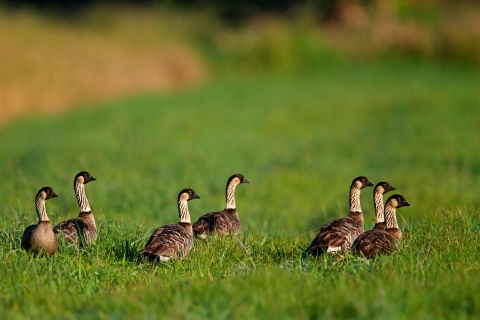Photo By/Credit
USFWS, Pacific Islands
Date Shot/Created
11/30/2021Media Usage Rights/License
Public Domain
Image
Recovery of endangered or threatened animals and plants is a primary goal of the Endangered Species Act. Conservation agencies and private landowners have made it possible to reestablish a population of nēnē once again in Hawaii.
After 60 years of collaborative conservation efforts among federal, state, NGOs and local partners, the Hawaiian Goose, or nēnē, is one step closer to recovery. An intensive captive breeding program, habitat restoration, and active management strategies have led to the nēnē’s return from the brink of extinction. As a result, the U.S. Fish and Wildlife Service has proposed downlisting the nēnē from endangered to threatened under the Endangered Species Act (ESA).
“It took decades of hard work and remarkable partnerships to bring nēnē back from the brink of extinction,” said Robyn Thorson, Regional Director for the Service’s Pacific Region. “Collaborative conservation efforts like this are the key to success in protecting and recovering Hawaii's native species.”
By the mid-twentieth century, fewer than 30 nēnē remained in the wild on a small area on the island of Hawai‘i. A further 13 birds survived in captivity. The nēnē was listed as an endangered species in 1967, and in the decades following, some 2,800 captive-bred birds were released at more than 20 sites throughout the main Hawaiian Islands. The release of captive-bred nēnē on national wildlife refuges, national parks and state and private lands saved the species from imminent extinction.
Today more than 2,800 individuals survive, with stable or increasing populations on Kaua‘i, Maui and Hawai‘i Island and an additional population on Moloka‘i.
As nēnē increase in numbers and expand their range, they face increased interaction and potential conflict with landowners and businesses. In addition to the downlisting, the Service is proposing a rule that would allow additional flexibility for landowners to manage nēnē on their property. This rule, under section 4(d) of the ESA, allows some types of actions that are normally prohibited under the ESA as long as those actions are consistent with conservation of the nēnē. If the proposed downlisting is finalized, the rule would give landowners management flexibility without reducing the effectiveness of conservation actions or the recovery of the species.
Collaboration is the key to the Service’s success in recovering imperiled wildlife. The Service is actively working with diverse partners to conserve imperiled species and to work toward fully recovering them so they can be removed from listing under the ESA. Downlisting species as they meet their recovery goals ensures we are continuing to use our resources to protect the most at-risk species.
After 60 years of collaborative conservation efforts among federal, state, NGOs and local partners, the Hawaiian Goose, or nēnē, is one step closer to recovery. An intensive captive breeding program, habitat restoration, and active management strategies have led to the nēnē’s return from the brink of extinction. As a result, the U.S. Fish and Wildlife Service has proposed downlisting the nēnē from endangered to threatened under the Endangered Species Act (ESA).
“It took decades of hard work and remarkable partnerships to bring nēnē back from the brink of extinction,” said Robyn Thorson, Regional Director for the Service’s Pacific Region. “Collaborative conservation efforts like this are the key to success in protecting and recovering Hawaii's native species.”
By the mid-twentieth century, fewer than 30 nēnē remained in the wild on a small area on the island of Hawai‘i. A further 13 birds survived in captivity. The nēnē was listed as an endangered species in 1967, and in the decades following, some 2,800 captive-bred birds were released at more than 20 sites throughout the main Hawaiian Islands. The release of captive-bred nēnē on national wildlife refuges, national parks and state and private lands saved the species from imminent extinction.
Today more than 2,800 individuals survive, with stable or increasing populations on Kaua‘i, Maui and Hawai‘i Island and an additional population on Moloka‘i.
As nēnē increase in numbers and expand their range, they face increased interaction and potential conflict with landowners and businesses. In addition to the downlisting, the Service is proposing a rule that would allow additional flexibility for landowners to manage nēnē on their property. This rule, under section 4(d) of the ESA, allows some types of actions that are normally prohibited under the ESA as long as those actions are consistent with conservation of the nēnē. If the proposed downlisting is finalized, the rule would give landowners management flexibility without reducing the effectiveness of conservation actions or the recovery of the species.
Collaboration is the key to the Service’s success in recovering imperiled wildlife. The Service is actively working with diverse partners to conserve imperiled species and to work toward fully recovering them so they can be removed from listing under the ESA. Downlisting species as they meet their recovery goals ensures we are continuing to use our resources to protect the most at-risk species.
Species
